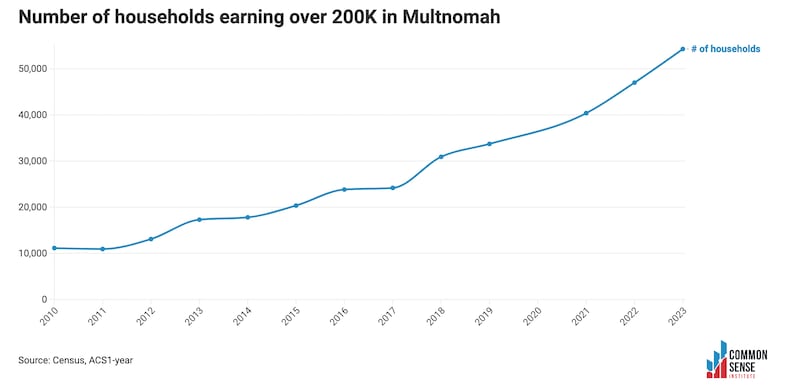A new study of U.S. Census Bureau data from the Common Sense Institute Oregon presents some sobering analysis about the state’s population trends.
“Oregon’s net migration ranking has fluctuated significantly over the years,” the study found. “In 2016, the state ranked 2nd, showing a high level of attractiveness for both domestic and international migrants. However, this trend has reversed, with Oregon’s rank falling to 24th in 2021, 42nd in 2022, and further to 45th in 2023. This decline reflects increased domestic outmigration, where more people are moving out of Oregon than arriving, as well as relatively low gains from international migration.”
Oregon showed a negative net migration in 2022 and 2023 (net migration is the sum of births minus deaths and the net inflow or outflow of residents).
Oregon is faring worse than all surrounding states except California, the study found. Here’s a graphic representation of the competition:

The study, co-authored by Serra Kirsch and Mark McMullen, the former Oregon state economist, pointed to two factors leading to Oregon’s population loss: the nation’s fifth-lowest birthrate and the high cost of living here.
“Looking at the fertility rate (the average number of children each woman will have over their lifetime), we are entering uncharted territory,” the study found. “A fertility rate of 2.1 is required to replace the existing population. Although every high-income country falls below this threshold, Oregon stands out. In the most recent data, Oregon’s fertility rate was 1.4, and appears to be dropping further.”
As for the cost of living, the study didn’t offer any policy prescriptions. As has been widely reported, Oregon is still struggling to come to grips with a widespread shortage of housing. “A higher relative cost of living may keep net migration low in the future,” the study found. “Oregonians are moving to lower-cost states, while healthy inflows of migrants continue from higher-cost areas. Households moving from California are leading the way as always.”
The news isn’t all bad, however. Even as complaints about Oregon and particularly the metro area’s high tax rates grow louder, the number of high-income households here has risen strongly.
“One interesting aspect of the 2023 data has been growth in the number of high-income households in the Portland area,” the study found. “Anecdotally, many such households have been driven from the city due to recent tax reforms. However, in Multnomah County, the number of households earning over $200,000 rose from around 40,000 in 2021 to 55,000 in 2023. This growth could still be consistent with anecdotes of households fleeing taxes. Income growth has been very strong, leading to more existing households crossing the $200,000 threshold.”

Whether Oregon can regain the net migration growth it enjoyed for many years is an important question for the state’s economic health, the study concludes.
“During every economic expansion since World War II, Oregon has experienced above-average rates of economic growth driven by inflows of migrants from other states. Many of these migrants have been young, working-age households in their root-setting years that represent the gold standard for economic development,” the study says. “The recent stall in population gains puts this traditional advantage into question going forward.”
